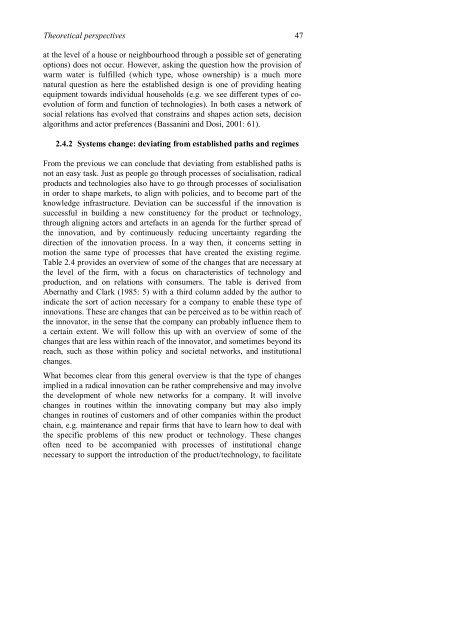Innovation and institutional change: the transition to a sustainable ...
Innovation and institutional change: the transition to a sustainable ...
Innovation and institutional change: the transition to a sustainable ...
You also want an ePaper? Increase the reach of your titles
YUMPU automatically turns print PDFs into web optimized ePapers that Google loves.
Theoretical perspectives 47<br />
at <strong>the</strong> level of a house or neighbourhood through a possible set of generating<br />
options) does not occur. However, asking <strong>the</strong> question how <strong>the</strong> provision of<br />
warm water is fulfilled (which type, whose ownership) is a much more<br />
natural question as here <strong>the</strong> established design is one of providing heating<br />
equipment <strong>to</strong>wards individual households (e.g. we see different types of coevolution<br />
of form <strong>and</strong> function of technologies). In both cases a network of<br />
social relations has evolved that constrains <strong>and</strong> shapes action sets, decision<br />
algorithms <strong>and</strong> ac<strong>to</strong>r preferences (Bassanini <strong>and</strong> Dosi, 2001: 61).<br />
2.4.2 Systems <strong>change</strong>: deviating from established paths <strong>and</strong> regimes<br />
From <strong>the</strong> previous we can conclude that deviating from established paths is<br />
not an easy task. Just as people go through processes of socialisation, radical<br />
products <strong>and</strong> technologies also have <strong>to</strong> go through processes of socialisation<br />
in order <strong>to</strong> shape markets, <strong>to</strong> align with policies, <strong>and</strong> <strong>to</strong> become part of <strong>the</strong><br />
knowledge infrastructure. Deviation can be successful if <strong>the</strong> innovation is<br />
successful in building a new constituency for <strong>the</strong> product or technology,<br />
through aligning ac<strong>to</strong>rs <strong>and</strong> artefacts in an agenda for <strong>the</strong> fur<strong>the</strong>r spread of<br />
<strong>the</strong> innovation, <strong>and</strong> by continuously reducing uncertainty regarding <strong>the</strong><br />
direction of <strong>the</strong> innovation process. In a way <strong>the</strong>n, it concerns setting in<br />
motion <strong>the</strong> same type of processes that have created <strong>the</strong> existing regime.<br />
Table 2.4 provides an overview of some of <strong>the</strong> <strong>change</strong>s that are necessary at<br />
<strong>the</strong> level of <strong>the</strong> firm, with a focus on characteristics of technology <strong>and</strong><br />
production, <strong>and</strong> on relations with consumers. The table is derived from<br />
Abernathy <strong>and</strong> Clark (1985: 5) with a third column added by <strong>the</strong> author <strong>to</strong><br />
indicate <strong>the</strong> sort of action necessary for a company <strong>to</strong> enable <strong>the</strong>se type of<br />
innovations. These are <strong>change</strong>s that can be perceived as <strong>to</strong> be within reach of<br />
<strong>the</strong> innova<strong>to</strong>r, in <strong>the</strong> sense that <strong>the</strong> company can probably influence <strong>the</strong>m <strong>to</strong><br />
a certain extent. We will follow this up with an overview of some of <strong>the</strong><br />
<strong>change</strong>s that are less within reach of <strong>the</strong> innova<strong>to</strong>r, <strong>and</strong> sometimes beyond its<br />
reach, such as those within policy <strong>and</strong> societal networks, <strong>and</strong> <strong>institutional</strong><br />
<strong>change</strong>s.<br />
What becomes clear from this general overview is that <strong>the</strong> type of <strong>change</strong>s<br />
implied in a radical innovation can be ra<strong>the</strong>r comprehensive <strong>and</strong> may involve<br />
<strong>the</strong> development of whole new networks for a company. It will involve<br />
<strong>change</strong>s in routines within <strong>the</strong> innovating company but may also imply<br />
<strong>change</strong>s in routines of cus<strong>to</strong>mers <strong>and</strong> of o<strong>the</strong>r companies within <strong>the</strong> product<br />
chain, e.g. maintenance <strong>and</strong> repair firms that have <strong>to</strong> learn how <strong>to</strong> deal with<br />
<strong>the</strong> specific problems of this new product or technology. These <strong>change</strong>s<br />
often need <strong>to</strong> be accompanied with processes of <strong>institutional</strong> <strong>change</strong><br />
necessary <strong>to</strong> support <strong>the</strong> introduction of <strong>the</strong> product/technology, <strong>to</strong> facilitate
















